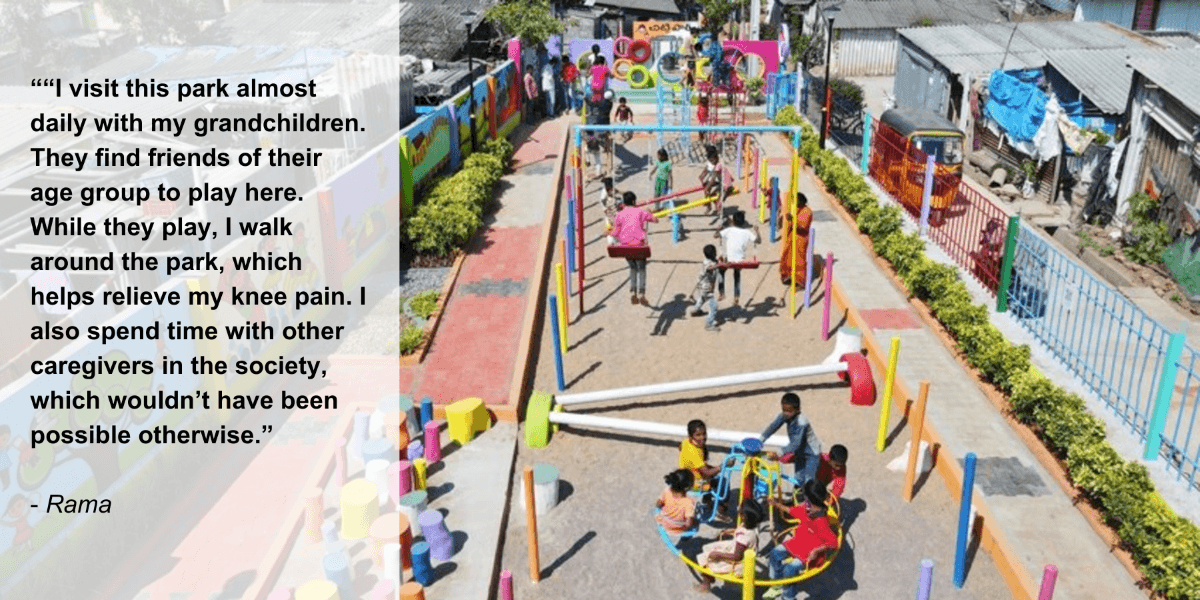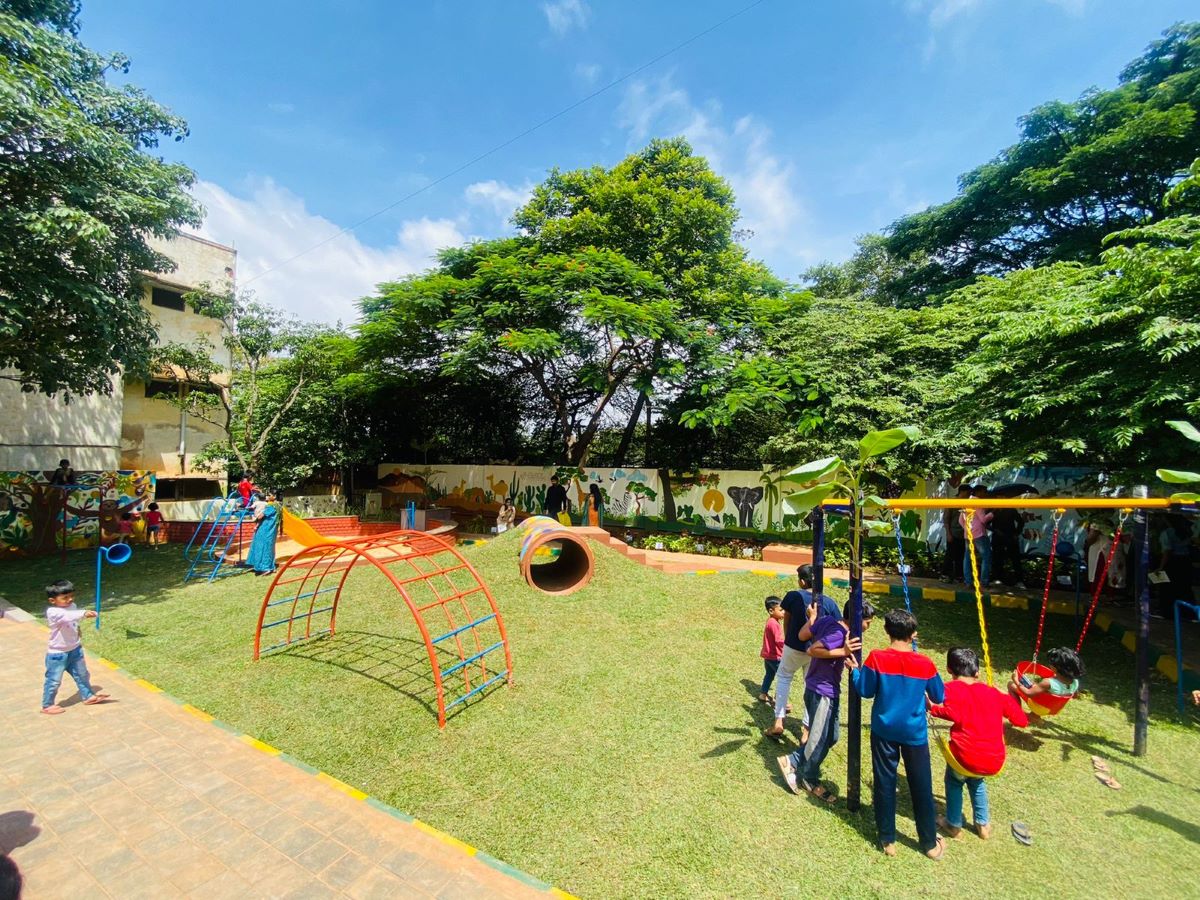
Humanizing Cities Through Public Spaces
This is the second blog in a three-part series on creating children and caregiver-friendly public spaces. It looks at how cities can overcome urban challenges to foster such spaces. Read the first blog in the series here.
In rapidly urbanizing India, cities largely focus on ensuring that infrastructure and housing cater to the rising demands of the growing population. While this is important, there is little focus on developing accessible public spaces that promote social interaction, community connections, and well-being of caregivers and young children. These interstitial urban spaces are crucial to enhancing the everyday lived experiences of people. Public spaces that facilitate interaction, learning and engagement between people of all ages, genders and socio-economic backgrounds are the essential building blocks of a healthy city.
The Nurturing Neighbourhoods Challenge (NNC) launched by the Ministry of Housing and Urban Affairs, Smart Cities Mission in collaboration with Van Leer Foundation and with the technical support of WRI India, resulted in a paradigm shift with its focus on people-centric, family-friendly urban environments. This helped bring communities together and enabled children and caregivers, especially women, to spend more time outdoors.
Here are five ways in which NNC cities are creating thriving public spaces across India:
- Clustering Young Children-Oriented Destinations
Creating accessible public spaces that bring young children and women-centric destinations together can enable women to spend more time outdoors. The city of Rourkela, through convergence with various national and state-level initiatives, implemented such a cluster. This included a play area for children, an Anganwadi, a multi-purpose community center, a mobile library and a community space around a temple. This led to more caregivers bringing their children to play as they engaged in various livelihood activities, peer interactions, reading and community meetings nearby. The increased footfall of women and children in the space has made it safer and has created a thriving environment for the community.

Multi-functional public space for all ages in Ruputola Slum in Rourkela, implemented by Rourkela Municipal Corporation (RMC) and Rourkela Smart City Ltd. (RSCL). Photo by Arunima Saha/WRI India.
- Carving out Public Spaces Through Community Consensus
Hilly cities face severe land constraints owing to their topography. Even the available land is often under private ownership. In such conditions, identifying abandoned and residual spaces through consensus with the local community and repurposing them into public spaces can be effective. In Kohima, such spaces have been reclaimed to develop pocket parks along streets, create a sensory park atop a public toilet block, and create play areas in government schools and hospitals, which are shared with the community. Co-creating such accessible public spaces with and for the community has enabled a sense of ownership. Local champions have emerged who are now actively involved in identifying and reclaiming multiple such spaces across the city.

The residents of Forest Colony in Kohima co-created a roadside pocket park using crowdsourced funds. The park has enabled families to spend more time outdoors. Photo by Sudipto Barua/WRI India.
- Creating Play Spaces for the Most Vulnerable
Children in densely packed, vulnerable settlements in cities seldom have access to play spaces within walking distance. Having public spaces within such neighborhoods that they can claim and call their own can significantly improve their overall well-being. A dump yard in the Chitti Park neighborhood in Warangal is one such example of an easily accessible, vibrant public space created with age-specific play opportunities for children and caregivers in the community. This has enabled not just the children in the neighborhood to play outdoors regularly but also made it possible for caregivers to interact with peers and make new friends.

Chitti Park in the densely packed MH Nagar Slum in Warangal offers safe outdoor playtime for children and their caregivers. Photo by Greater Warangal Municipal Corporation.
- Creating Doorstep Play Opportunities in Neighborhoods
Having play opportunities near homes can increase the time children spend playing outdoors, which aids their cognitive development. Kochi and Bengaluru have created doorstep play opportunities with community participation for young children and caregivers by reclaiming under-utilized pockets in dense neighborhoods. These neighborhood-level public spaces are adaptable and provide age-appropriate play opportunities for children, spaces for socializing for caregivers, especially women, and often serve as meeting and resting places for SHG (self-help group) workers.

Puttani Park, created as a doorstep public space in the KSRTC Colony, Bengaluru, has led to families spending more time outside. Photo by Suhani Gupta/WRI India.

Streetside public space at Poovath Street, Fort Kochi, is actively used by people of all age groups in the vicinity. Photo by Visakha KA/WRI India.
- Transforming Anganwadis and Health Centers into Playful Public Spaces
Anganwadis and healthcare centers are frequented by young children and their caregivers. Providing play opportunities can enhance the learning environment in Anganwadis and offer much-needed relief from the stressful experience of a hospital.
In Sanskriti Nagar, Indore, a flood-prone area has been transformed with a nature-based approach into a vibrant public space with an Anganwadi. It offers play opportunities for children and serves as a community hub/anchor for nearby residents.
Similarly, the BBMP Maternity Home in Bengaluru, which receives a high footfall of pregnant women and women with infants and toddlers, has also been transformed. It has a dedicated seating area in front of the OPD, a herb garden, and a toddlers’ play area. This new space has helped caregivers better engage children and sit comfortably for long hours, making the hospital environment relatively stress free.

Open play and recreational space around the Anganwadi in Sanskriti Nagar in Indore. Photo by Kshitija Pendharkar/WRI India.

Comfortable seating and play space added in the BBMP Maternity Home premises in Bengaluru. Photo by Directorate of Urban Land Transport.
NNC has clearly demonstrated the profound impact that these public spaces, built using just a few resources, can have on people’s well-being. As Indian cities expand, prioritizing public spaces that bring people together and provide a supportive environment for communities is crucial for making our cities more humane and livable. Cities can greatly benefit by creating strategies for scaling such public spaces and taking action towards their sustenance. Establishing diverse partnerships among government bodies, NGOs, private stakeholders and community champions, along with strengthening capacities and adopting conducive policies, can help ensure sustained urban growth where communities thrive together.